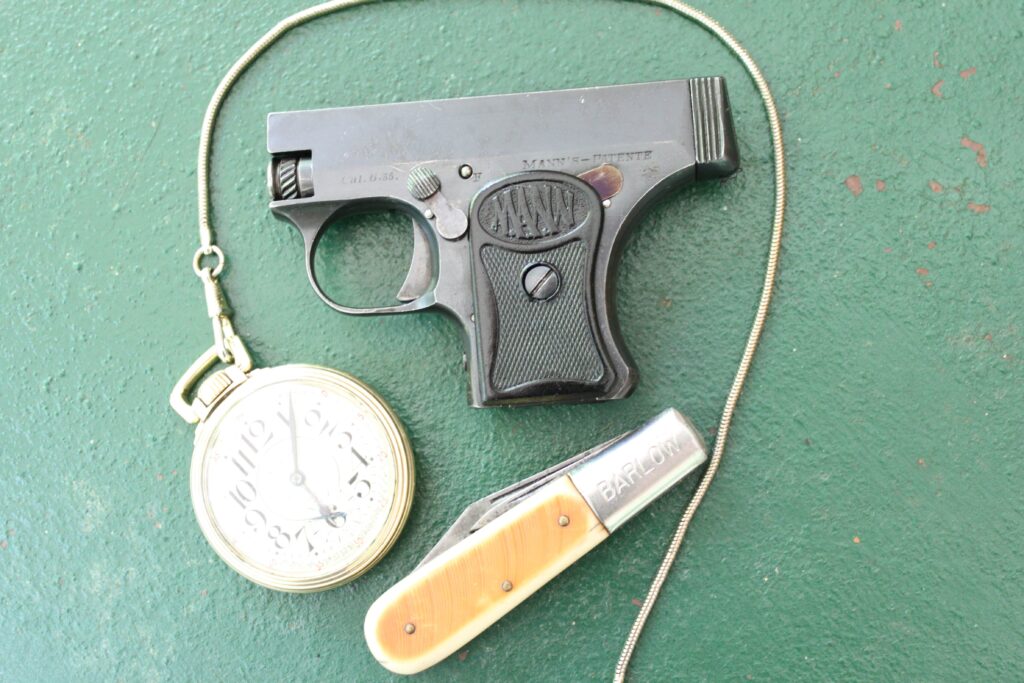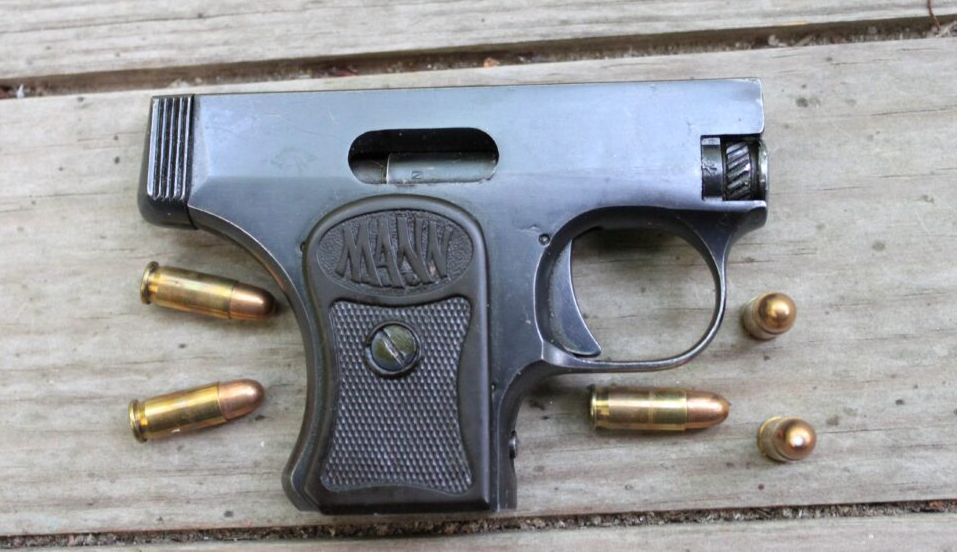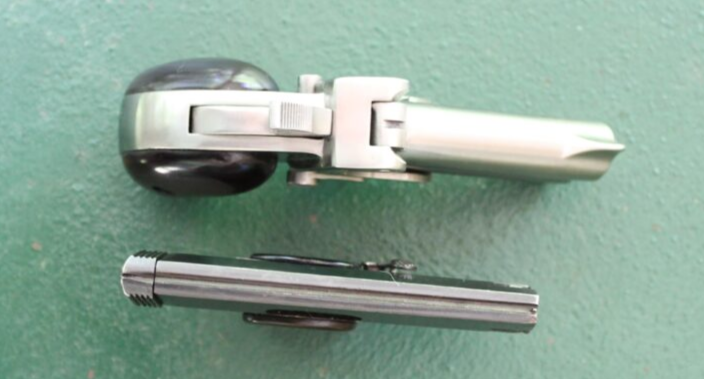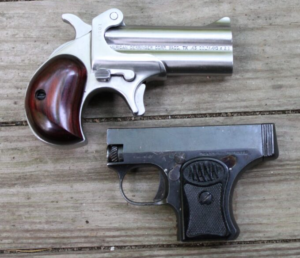
By Jim Dickson | Contributing Writer
The Mann .25 ACP is the most versatile of all the .25 ACP automatics because it’s unique shape, tiny size and extreme thinness allows it to be secreted in places the Browning type .25 automatics cannot.
Only 2.75 inches high by 4 inches long and only 0.56 inch thick with the grips bringing the width up to 0.74-inch, the Mann pistol’s T shape does not even print as a gun as it rides securely upside down in a watch or vest pocket perfectly positioned to be grasped and drawn with no fumbling.
At only 8 ounces it is noticeably lighter than other .25 ACP pistols and this makes it less likely to bounce out of a pocket during exertion. It rides unnoticed in the pocket of swim trunks and was often carried in change purses. In the days of the greenback bills, wallets were of necessity larger and it was not uncommon for a little Mann .25 ACP to nestle concealed within one. While I have seen a change purse made to exactly fit the Mann .25, I have never seen or heard of a holster for one as it was always carried in a vest or watch pocket. Today it also fits perfectly in the pocket of a T shirt.

While a Browning .25 ACP is small, it is more noticeable and prints as a gun while it’s conventional shape renders it less certain to grasp and draw from a vest pocket. The Mann is the only .25-caliber semi-automatic that crosses the line into the deep cover gun category.
The Mann may appear strange to those conditioned by looking at conventional guns but it is ergonomically superior to its rivals. It nestles comfortably in the hand and points naturally and, more important, accurately. It is the easiest .25 auto with which to hit the target. Recoil is virtually non-existent and the little pistol is fun to shoot.

There is a gutter channel sight with an infinitesimally small front sight for those inclined to take a sight picture. The point blank ranges at which a .25 auto is normally used to shoot an attacker render sights superfluous in most actual use situations. The magazine holds five rounds so you have the same number of shots as a Colt Single Action Army revolver with the hammer down on an empty chamber.
The safety is well positioned for the thumb to reach, on the frame in front of the grips. Due to size limits of the gun it only acts on the trigger bar but that is normally sufficient.
There is no slide to increase the width of this gun. The Mann is the only retarded blowback bolt .25 auto ever made. An annular ring 3mm wide, 1mm deep, with beveled edges in the chamber caused the cartridge case to expand into this ring retarding opening of the gun sufficiently to enable a light weight internal bolt to be used instead of a bulky, heavy slide.
Disassembly of the Mann is difficult for the uninitiated due to its lack of similarity to conventional guns so pay attention to how it’s done. Considering how hard it is to remove the pins I think that it is safe to say that the factory only intended these to be removed when a part needed changing and unless that is the case I would leave them strictly alone. It is all too easy to mar the finish of the pins and the pistol and they should be left alone if at all possible.
1 Press the button at the front of the grip to release the magazine and withdraw the magazine.
2 Withdraw the bolt just under a half inch and hold it back while you turn the knurled end of the barrel counterclockwise as viewed from the front for a quarter turn allowing the barrel to be moved forward off the gun.
3 Use care when unscrewing the powerful recoil spring guide from the front as it and the recoil spring want to come out forcefully.
4 Viewed from the rear, unscrew the bolt knob counterclockwise and pull the firing pin and spring out the back.
This is as far as field stripping goes.
5 Remove the grip screws and grips but don’t loosen the sideplate when it falls out as you take the left grip off.
6 Pull the threaded portion of the breechblock to the rear as far as it wil go and hold it there while you use a small screwdriver through the barrel channel to disengage the tip of the ejector from the frame allowing the ejector to be pulled forward and out
7 Now we come to the pins. Stop right here unless you need to change a part. Pay particular attention to the position of the sear and the sear spring, especially the way the hole in the leaf sear spring fits on a pip on the sear. Drift out the sear spring using extreme care as it won’t want to come out. Now remove the sear and sear spring.
8 Withdraw the breechblock forward.
9 The rest of the parts come out after drifting out their pins. Begin with the trigger pin, trigger bar, magazine catch pivot, magazine catch and spring in that order.
10 Reassemble in reverse order but note the following exceptions. After reinserting the breechblock, the sear and its pin should be replaced without the spring. Insert the spring by sliding it under its retaining pin just under the sear pin. Now lever the tip with its hole up with a sharp pointed tool so that the hole in the spring snaps over the pip on the sear. This is a difficult operation needing the frame to be clamped in a soft jawed vise at it’s rear with the front pointing up. Push the sear spring up the magazine well with a small screwdriver with one hand while using the sharp pointed tool through one of the grip openings with the other hand.
You can see now why I said these instructions were important.
If you have a Mann that needs gunsmith work, I can recommend Eugene Golubstov at Lugerman.com.
The Mann is a lot of fun to shoot and I was glad I had 300 rounds of Prvi Partizan .25 ACP, 50 grain at 771 FPS and 350 rounds of Remington .25 ACP, 50 grain at 760 FPS. The little gun is capable of some very fast rapid fire, spitting out five shots faster than you might think. It is easy to keep all the shots in the kill zone at the ranges you will face a close quarters attack.
A lot of people want to put down the .25ACP because it is not a manstopper like a .45. Indeed, a .45 cartridge is almost as thick as the little Mann. The .25 can be lethal, and if it does not do it fast, it is letting the steam out of an attacker’s boiler so he is more easily manhandled.
While some claim the .22LR is superior out of the same size gun tests have shown the .25 ACP has more penetration and more energy than even the hottest .22LR out of vest pocket pistols.
I cannot stress the importance of penetration in a small handgun. No amount of bullet expansion if going to make a noticeable difference in stopping power but it will drastically reduce your penetrating power, perhaps enough to get you killed in some circumstances. In addition, the centerfire .25ACP is a far more reliable cartridge than the .22 rimfire, which is prone to misfires and its rimmed cartridge is more prone to jams. This is why the .25 ACP is so popular.
After The Great War (nowadays called World War I) Europe was racked with crime, riots, and Bolsheviks. Most men took to carrying a pistol in their vest pocket and many had to employ them. The .25ACP pistols worked well enough that they became as standard a carry item as a watch or a handkerchief for most men.
This was the market that Fritz Mann entered in 1920. He had founded his company with his brother, Otto and one of Fritz’s sons, Willi in 1896 as Frittz Mann Feinmachen-Waffen-Und Werkszeugfab in Suhlerndorf, Thuringia, Germany. All three were excellent gun designers and they also turned out precision machined products ranging from two-stroke engines to buzz saws and even ski bindings and crash helmets.
Looking at the market for vest pocket pistols, Fritz saw that men wanted the smallest available. Fritz knew that he could do better than John Browning at designing one and he did with one of the most futuristic and advanced pistols of all time. Unfortunately, it was too advanced for most people. The old saying “If you build a better mousetrap the world will beat a path to your door” has been disproved over and over throughout history as radically improved and advanced designs have been too different for the public to grasp.
Production began in 1920 and there were minor differences in the guns made in 1921. The earliest guns had wood grips while the later 1920 production guns featured aluminum grips. In 1921 the grips were changed to hard rubber and the loaded chamber indicator on the right side of the pistol was eliminated. There were also minor changes to the form and checkering of the grip safety and to the cover plate and position of the grip screws. The year of production’s last two digits were put on the front of the grip.
According to an old catalog there was an optional 150mm barrel for target shooting available but none seems to have survived. As the Mann barrel is so easy to change, the few long barrels were presumably not kept on the gun and were lost over the next 100 years.
Despite the innovations the Mann .25 did not have a long production run and by 1924 had disappeared from the various gun sales catalogs. It remains today, the finest .25ACP ever made.





